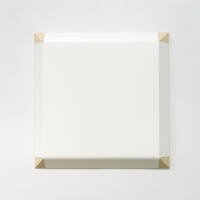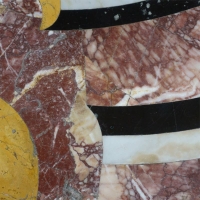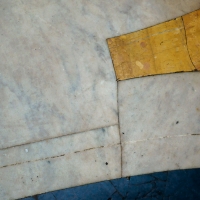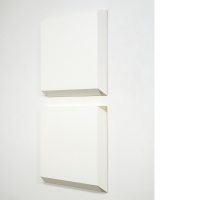The gallery is pleased to present simultaneously Stéphane La Rue’s last paintings and his first photographs. The two approaches start from the same reflection on art and its representations.
The series titled “Sols inapparents” results from a 6-month stay in Rome. Painter and non-photographer, La Rue disciplines himself with the camera, treating it as his only working tool. He compels himself to look differently at his new environment.
“While visiting churches and basilicas, I became entranced by the marble floors. My initial photographs were particularly concerned with their decorative aspect but to study these floors, I had to look at them closely and in detail. I looked at them through the lens of the camera from every possible point of view. The geometric patterns of the floors brought me to see space as perspective, an illusionist plan. Grooves, transparencies, colours, geometric patterns, all the anomalies created by the wear of time, helped to build my images. My intention no longer was to build a repertory. The floors themselves became the matrices of my explorations.”
The title of the corpus,“Sols inapparents” (Unseen Ground), borrowed from the poet Gilles Cyr, draws our attention toward the fact that our gaze on the floors of churches and basilicas is habitually a careless gaze which is met by seductive architectural and decorative surfaces forcing us to us look up!
Formal exploration of the Roman floors recalls recurring themes in the artist’s work. The wood frames of the paintings of La Rue reminds us of the veins and textures of marble floors, intersecting with geometric patterns and boundaries between space, surface and volumes. As in his pictorial work, the recognized connections of materiality and attention to forms and to planes, dominate. Photography, intrinsically of the order of illusion, makes us want to review, that is, to re-see, the meaning of La Rue’s painting as object.
“I reflect on the impossibility of representation. Yet these images, while representing floors, transport us to a strange space. I question the passage (or rather the possible back and forth) between photography and painting, the need to contact the material despite the use of technological tools.”
This series, based upon a stay in Rome, reveals itself to be an important locus of exploration. It renews La Rue’s pictorial language through photography by radically investigating illusionist space.
Confirming La Rue’s process, this new path integrates perfectly into his chosen formal language and gives added depth to his handling of subjects, shapes and materials. La Rue’s photographic project always refers to painting, but to painting which, by rediscovering the world, takes it in hand and reinvents it.




















